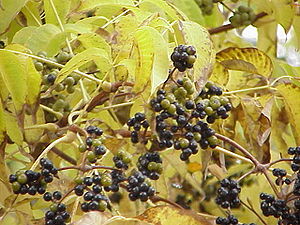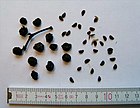Note: This is a project under development. The articles on this wiki are just being initiated and broadly incomplete. You can Help creating new pages.
Difference between revisions of "Phellodendron - Cork-tree"
Chaithrika (talk | contribs) m (Chaithrika moved page Cork-tree to Phellodendron: Renaming as per convention) |
|||
| (15 intermediate revisions by 2 users not shown) | |||
| Line 1: | Line 1: | ||
[[File:Phellodendron amurense0.jpg|thumb|right|''Cork-tree'', ''Phellodendron'']] | [[File:Phellodendron amurense0.jpg|thumb|right|''Cork-tree'', ''Phellodendron'']] | ||
| + | '''Cork-tree or Phellodendron''' is a genus of deciduous trees in the family Rutaceae. It is native to east and northeast Asia. | ||
| + | ==Uses== | ||
| + | {{Uses|Psoriasis}}, {{Uses|Ulcers}}, {{Uses|Osteoarthritis}}, {{Uses|Obesity}}, {{Uses|Diabetes}}, {{Uses|Meningitis}}, {{Uses|Pneumonia}}, {{Uses|Diarrhea}}, {{Uses|Eye infections}}. | ||
| − | + | ==Parts Used== | |
| + | {{Parts Used|Fruits}}. | ||
| + | |||
| + | ==Chemical Composition== | ||
| + | The major chemical constituents in the bark of P. amurense are alkaloids of the isoquinoline type. Alkaloids isolated from the bark of P. amurense are berberine, palmatine, magnoflorine, phellodendrine, candicine , and jatrorrhizine.<ref name="chemical composition"/> | ||
| + | |||
| + | ==Common names== | ||
| + | {{Common names|kn=|ml=|sa=|ta=|te=|hi=|en=Agrimony}} | ||
| + | |||
| + | ==Properties== | ||
| + | Reference: Dravya - Substance, Rasa - Taste, Guna - Qualities, Veerya - Potency, Vipaka - Post-digesion effect, Karma - Pharmacological activity, Prabhava - Therepeutics. | ||
| + | ===Dravya=== | ||
| + | |||
| + | ===Rasa=== | ||
| + | |||
| + | ===Guna=== | ||
| + | |||
| + | ===Veerya=== | ||
| + | |||
| + | ===Vipaka=== | ||
| + | |||
| + | ===Karma=== | ||
| + | |||
| + | ===Prabhava=== | ||
| + | |||
| + | ==Habit== | ||
| + | {{Habit|Deciduous tree}} | ||
| + | |||
| + | ==Identification== | ||
| + | ===Leaf=== | ||
| + | {{Leaf|Opposite|Pinnately compound|5 to 11 leaflets per leaf and leaves are 10" to 15" long}}<ref name="Leaf"/> | ||
| + | |||
| + | ===Flower=== | ||
| + | {{Flower|Unisexual|2-4cm long|Greenish-yellow|5-20|Not ornamentally significant blooms in late May and early June}} | ||
| + | |||
| + | ===Fruit=== | ||
| + | {{Fruit||Pea-sized fruits|Aromatic when crushedonly on female plants held in clusters|Change from green to black|}} | ||
| + | |||
| + | ===Other features=== | ||
| + | |||
| + | ==List of Ayurvedic medicine in which the herb is used== | ||
| + | * [[Vishatinduka Taila]] as ''root juice extract'' | ||
| + | |||
| + | ==Where to get the saplings== | ||
| + | ==Mode of Propagation== | ||
| + | {{Propagation|Seeds}}. | ||
| + | |||
| + | ==How to plant/cultivate== | ||
| + | As an ornamental plant, Phellodendron is a tree for all seasons. In spring it has yellow flowers, in summer it provides foliage and shade.<ref name="How to plant/cultivate"/> | ||
| + | |||
| + | ==Commonly seen growing in areas== | ||
| + | {{Commonly seen|Tall grasslands}}, {{Commonly seen|Meadows}}, {{Commonly seen|Borders of forests}}. | ||
| + | |||
| + | ==Photo Gallery== | ||
| + | <gallery class="left" caption="" widths="140px" heights="140px"> | ||
| + | Morlanwelz Mariemont JPG19a.JPG | ||
| + | |||
| + | |||
| + | Morlanwelz Mariemont JPG19b.JPG | ||
| + | |||
| + | |||
| + | Morlanwelz Mariemont JPG19d.JPG | ||
| − | |||
| − | + | Phellodendron amurense JPG1a.jpg | |
| − | + | ||
| + | Phellodendron amurense JPG1b.jpg | ||
| − | |||
| − | + | Phellodendron amurense JPG1f.jpg | |
| − | |||
| − | + | ||
| + | Phellodendron amurense JPG1fa.jpg | ||
| − | + | ||
| + | Phellodendron amurense JPG2a.jpg | ||
| − | |||
| − | + | Amur-Korkbaum Fruechte Samen.jpg | |
| + | |||
| + | </gallery> | ||
| + | |||
| + | ==References== | ||
| + | |||
| + | <references> | ||
| + | <ref name="chemical composition">[https://link.springer.com/chapter/10.1007%2F978-3-642-73739-8_95 Chemical constituents]</ref> | ||
| + | |||
| + | <ref name="Leaf">[http://www.hort.uconn.edu/plants/detail.php?pid=305 Plant Database]</ref> | ||
| + | |||
| + | <ref name="How to plant/cultivate">[https://pfaf.org/user/Plant.aspx?LatinName=Phellodendron+lavallei Cultivation details]</ref> | ||
| + | </references> | ||
| + | |||
| + | ==External Links== | ||
| + | * [https://www.chrysalisnaturalmedicine.com/phellodendron-bark-phellodendron-amurense/ Phellodendron on chrysalis natural medicine] | ||
| + | * [https://www.webmd.com/vitamins/ai/ingredientmono-1095/phellodendron Overview Information of Phellodendron] | ||
| + | * [http://www.missouribotanicalgarden.org/PlantFinder/PlantFinderDetails.aspx?kempercode=a889 Phellodendron on missouribotanicalgarden] | ||
| + | * [https://onlinelibrary.wiley.com/doi/abs/10.1002/ffj.1349 Chemical composition of the essential oils from fruits, leaves and flowers] | ||
[[Category:Herbs]] | [[Category:Herbs]] | ||
| + | [[Category:Ayurvedic herbs that don't have flower, fruit and leaf photos]] | ||
| + | [[Category:Rutaceae]] | ||
Latest revision as of 10:49, 1 July 2020
Cork-tree or Phellodendron is a genus of deciduous trees in the family Rutaceae. It is native to east and northeast Asia.
Contents
- 1 Uses
- 2 Parts Used
- 3 Chemical Composition
- 4 Common names
- 5 Properties
- 6 Habit
- 7 Identification
- 8 List of Ayurvedic medicine in which the herb is used
- 9 Where to get the saplings
- 10 Mode of Propagation
- 11 How to plant/cultivate
- 12 Commonly seen growing in areas
- 13 Photo Gallery
- 14 References
- 15 External Links
Uses
Psoriasis, Ulcers, Osteoarthritis, Obesity, Diabetes, Meningitis, Pneumonia, Diarrhea, Eye infections.
Parts Used
Chemical Composition
The major chemical constituents in the bark of P. amurense are alkaloids of the isoquinoline type. Alkaloids isolated from the bark of P. amurense are berberine, palmatine, magnoflorine, phellodendrine, candicine , and jatrorrhizine.[1]
Common names
| Language | Common name |
|---|---|
| Kannada | |
| Hindi | |
| Malayalam | |
| Tamil | |
| Telugu | |
| Marathi | NA |
| Gujarathi | NA |
| Punjabi | NA |
| Kashmiri | NA |
| Sanskrit | |
| English | Agrimony |
Properties
Reference: Dravya - Substance, Rasa - Taste, Guna - Qualities, Veerya - Potency, Vipaka - Post-digesion effect, Karma - Pharmacological activity, Prabhava - Therepeutics.
Dravya
Rasa
Guna
Veerya
Vipaka
Karma
Prabhava
Habit
Identification
Leaf
| Kind | Shape | Feature |
|---|---|---|
| Opposite | Pinnately compound | 5 to 11 leaflets per leaf and leaves are 10" to 15" long |
Flower
| Type | Size | Color and composition | Stamen | More information |
|---|---|---|---|---|
| Unisexual | 2-4cm long | Greenish-yellow | 5-20 | Not ornamentally significant blooms in late May and early June |
Fruit
| Type | Size | Mass | Appearance | Seeds | More information |
|---|---|---|---|---|---|
| Pea-sized fruits | Aromatic when crushedonly on female plants held in clusters | Change from green to black | {{{6}}} |
Other features
List of Ayurvedic medicine in which the herb is used
- Vishatinduka Taila as root juice extract
Where to get the saplings
Mode of Propagation
How to plant/cultivate
As an ornamental plant, Phellodendron is a tree for all seasons. In spring it has yellow flowers, in summer it provides foliage and shade.[3]
Commonly seen growing in areas
Tall grasslands, Meadows, Borders of forests.
Photo Gallery
References
External Links
- Ayurvedic Herbs known to be helpful to treat Psoriasis
- Ayurvedic Herbs known to be helpful to treat Ulcers
- Ayurvedic Herbs known to be helpful to treat Osteoarthritis
- Ayurvedic Herbs known to be helpful to treat Obesity
- Ayurvedic Herbs known to be helpful to treat Diabetes
- Ayurvedic Herbs known to be helpful to treat Meningitis
- Ayurvedic Herbs known to be helpful to treat Pneumonia
- Ayurvedic Herbs known to be helpful to treat Diarrhea
- Ayurvedic Herbs known to be helpful to treat Eye infections
- Herbs with Fruits used in medicine
- Herbs with common name in English
- Habit - Deciduous tree
- Index of Plants which can be propagated by Seeds
- Herbs that are commonly seen in the region of Tall grasslands
- Herbs that are commonly seen in the region of Meadows
- Herbs that are commonly seen in the region of Borders of forests
- Herbs
- Ayurvedic herbs that don't have flower, fruit and leaf photos
- Rutaceae









